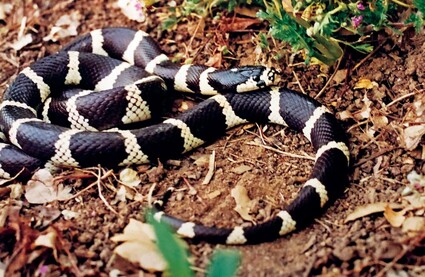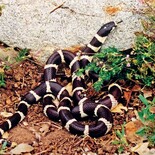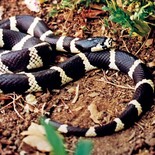Crownless but definitely the kings
Land of Four Seasons
August 19, 2023

Jon Hammond.
Though they don't look very intimidating, Kingsnakes can kill and swallow snakes bigger than themselves, including rattlesnakes.
There is a species of gentle snake found throughout the Tehachapi Mountains, a familiar reptile with alternating light and dark rings the length of its sinuous body. Though it is non-venomous, and doesn't seem very imposing, this snake is actually the undisputed ruler of the local reptile world, as so has been given a regal name: the Kingsnake.
California Kingsnakes (Lampropeltis californiae) are typically fairly long, slender snakes with narrow heads that are not much larger than their bodies. Though commonly described as having black and white bands, the lighter bands actually tend to be more cream-colored than truly white, and the dark rings can range from shiny coal black to light mahogany brown.
Probably the only snakes that are more common in our area are Great Basin Gophersnakes (Pituophis catenifer deserticola) – those and California Kingsnakes are typically the ones that you're most likely to encounter.
Kingsnakes get their name because they not only hunt common snake prey like lizards, small mammals, bird eggs, etc., they also devour other snakes, including Northern Pacific Rattlesnakes (Crotalus oreganus oreganus).
So how is this possible? How does a slender, non-venomous snake kill and swallow rattlesnakes? The simple reason is that California Kingsnakes are highly resistant or immune to rattlesnake venom. This superpower apparently evolved over a long period of time, and Kingsnakes are only immune to the venom of the rattlesnakes in their area, not all venomous snakes.
Apparently the Kingsnakes have enzymes and antibodies in their blood that help break down the rattlesnake venom and offer them protection. At this point, it is not well understood exactly how Kingsnakes defeat the effects of the venom, but they clearly do, and their resistance isn't acquired from repeated bites, they are born (or hatched, actually) with this immunity.
Okay, so Kingsnakes are immune to rattlesnake venom, but how do they overpower them, since rattlesnakes often have thicker bodies? They do this easily because Kingsnakes are constrictors, and kill by squeezing prey with their powerful, muscular bodies.
Rattlesnakes, on the other hand, strike their prey, inject venom, and then immediately release and wait for the venom to do its job. Rattlesnakes are not very muscular compared to constrictors. I remember the first time I held a live rattlesnake, and was amazed by how squishy its body was compared to the sinewy constrictors like Gophersnakes and Kingsnakes that I had grown up catching.
I have a friend who has seen Kingsnakes consume rattlesnakes on two occasions, and he said that the Kingsnakes were so dominant that the rattlesnakes didn't even seem to put up a fight. And contrary to one of the many ridiculous myths about snakes, Kingsnakes do not get rattlesnakes to somehow bite themselves and die from their own venom, the Kingsnake simply squeezes the rattlesnake like they would other prey.
Kingsnakes definitely eat other snakes, but snakes are not their only, or even their most common prey. Kingsnakes more frequently eat lizards, mice, voles, frogs, eggs of all kinds, including reptile eggs, birds, chicks, and even large invertebrates.
Kingsnakes are not especially large, averaging about two and one-half to three and one-half feet in length. They tend to have a docile nature, and while I have been bitten by Kingsnakes a few times over the years, they immediately let go and their teeth are sharp but very tiny, leaving just a few minute pinpricks of blood on my hand or arm.
With their strong, ropy bodies and fondness for eggs, Kingsnakes are good climbers and will sometimes move through the lower branches of trees or shrubs, looking for bird nests to rob.
California Kingsnakes are found in many different habitat types, and the Tehachapi Mountains are considered the highest elevation where they are found in the southern portion of their range -- in areas more than 6,100 feet above sea level.
While they typically don't strike when you pick them up, Kingsnakes (especially females) that are frightened may excrete musk and fecal matter, so that you get this unpleasant-smelling material on your hands while holding them. Captive snakes that are used to being held rarely engage in this antisocial behavior.
California Kingsnakes are found throughout much of our state, and into parts of Arizona, Nevada and a small portion of Utah. They have a wide range of pattern variations, including snakes that are mostly black, or with long parallel stripes instead of bands, and some even have a dotted pattern like perforation marks that are referred to as the "Highway Stripe" morph.
As fairly small predators, California Kingsnakes are also prey themselves, and though they may rule the herpetofauna, they may get predated by hawks, owls, coyotes, foxes, bobcats, etc.

Jon Hammond.
My daughter Kiya holding a Kingsnake when she was four years old. She frequently had Kingsnakes that we rescued from roadways for a week or two before releasing them.
You'd think that the alternating light and dark bands on a conventionally-colored California Kingsnake would make them easy to spot, but this design actually helps break up their silhouette or form. In an area of mixed sunlight and shade, in particular, these snakes are hard to spot unless they are crawling.
Kingsnakes are quiet, unassuming reptiles that tend to move nearly silently through the landscape, and while they are not the biggest or loudest snakes, they are the Kings. . .
Jon Hammond is a fourth generation Kern County resident who has photographed and written about the Tehachapi Mountains for 38 years. He lives on a farm his family started in 1921, and is a speaker of Nuwä, the Tehachapi Indian language. He can be reached at tehachapimtnlover@gmail.com.







